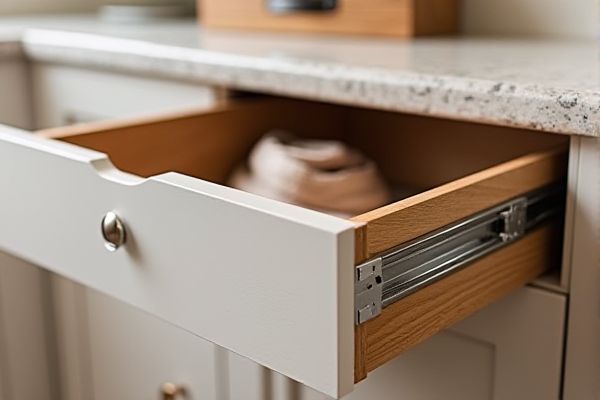
Ball bearing slides offer smooth, quiet motion and higher load capacity compared to roller slides, making them ideal for heavy-duty drawer applications. Explore the detailed comparison to determine which slide type best suits your drawer needs.
Table of Comparison
| Feature | Ball Bearing Slides | Roller Slides |
|---|---|---|
| Load Capacity | High (up to 500 lbs) | Medium (up to 100 lbs) |
| Smoothness | Very smooth, quiet operation | Less smooth, may produce noise |
| Durability | Long-lasting, withstands heavy use | Moderate lifespan, best for light use |
| Extension | Full or over-travel extensions available | Typically partial extension |
| Installation Complexity | Moderate, precise alignment required | Simple installation |
| Cost | Higher | Lower |
| Common Applications | Heavy-duty furniture, industrial drawers | Light residential drawers, economy furniture |
Introduction to Drawer Slide Mechanisms
Ball bearing slides and roller slides are two common types of drawer slide mechanisms, each offering distinct performance characteristics. Ball bearing slides use steel balls to provide smooth, quiet operation and support heavy loads, making them ideal for high-quality cabinetry and industrial applications. Roller slides, on the other hand, employ nylon or steel rollers that glide along tracks, offering easier installation and cost-effectiveness but typically handling lighter loads and less smooth motion compared to ball bearing slides.
What Are Ball Bearing Slides?
Ball bearing slides use small steel balls within the track to provide smooth, quiet, and durable drawer movement, offering high load capacity and long-lasting performance. These slides are ideal for heavy-duty applications where stability and precision are crucial, such as in kitchen cabinets and industrial drawers. Selecting ball bearing slides ensures your drawers operate reliably with minimal friction and enhanced longevity.
What Are Roller Slides?
Roller slides are drawer slides that use rolling plastic or nylon wheels running along a metal track to enable smooth drawer movement. Unlike ball bearing slides, which utilize ball bearings for quieter and more durable operation, roller slides tend to be more affordable but may produce more friction and noise over time. If you prioritize budget and light-duty use, roller slides offer a straightforward solution for your drawer functionality.
Key Differences Between Ball Bearing and Roller Slides
Ball bearing slides feature steel balls running along a smooth track, providing smoother, quieter, and more durable drawer movement compared to roller slides, which use plastic or nylon wheels on a metal track. Ball bearing slides offer higher weight capacity and better resistance to wear and tear, making them ideal for heavy-duty or high-frequency use, while roller slides are more cost-effective and suitable for lighter applications. Installation complexity also varies, with ball bearing slides typically requiring more precise alignment than the simpler roller slides.
Load Capacity: Ball Bearing vs. Roller Slides
Ball bearing slides typically offer higher load capacity compared to roller slides, supporting weights ranging from 75 to over 500 pounds, ideal for heavy-duty drawer applications. Roller slides usually accommodate lighter loads, generally up to 100 pounds, making them suitable for standard residential or office furniture. The enhanced durability and smooth operation of ball bearing mechanisms make them preferable for applications requiring robust support and frequent use.
Smoothness and Operation: User Experience
Ball bearing slides offer superior smoothness and quiet operation due to precisely engineered steel balls that reduce friction, enhancing your drawer's glide quality. Roller slides, typically made with nylon or plastic wheels, provide less smooth motion and can become noisy over time under heavy use. For optimal user experience, ball bearing slides ensure effortless, consistent performance, especially in high-traffic or weight-bearing applications.
Durability and Maintenance Comparison
Ball bearing slides offer superior durability with their steel ball system that ensures smooth, consistent movement and higher load capacity compared to roller slides, which use cylindrical rollers prone to wear over time. Maintenance for ball bearing slides is minimal due to their sealed design that resists dust and debris, whereas roller slides may require more frequent lubrication and cleaning to prevent rattling and sticking. Your choice should consider long-term reliability and ease of upkeep, where ball bearing slides typically provide a more robust and maintenance-friendly solution.
Installation and Compatibility Factors
Ball bearing slides offer smooth, quiet operation with precise alignment, making installation slightly more complex due to their need for accurate mounting surfaces and compatible cabinet dimensions. Roller slides are generally easier to install and more forgiving on imperfect cabinet openings, but they require sufficient clearance and may not support heavy loads as effectively as ball bearing slides. Your choice depends on the drawer weight, cabinet compatibility, and the desired durability of the slide mechanism for optimal performance.
Cost Analysis: Ball Bearing vs. Roller Slides
Ball bearing slides typically cost more upfront than roller slides due to their complex design and higher precision materials, ensuring smoother and quieter operation under heavier loads. Roller slides are generally more affordable and easier to replace but may suffer from reduced durability and increased noise over time. Businesses should weigh long-term maintenance expenses and performance requirements when choosing between ball bearing and roller drawer slides.
Choosing the Right Drawer Slide for Your Needs
Ball bearing slides offer smooth, quiet operation and higher load capacity, making them ideal for heavy-duty drawers in kitchens or offices. Roller slides provide a more cost-effective solution with easier installation but may produce more noise and limited weight support, suitable for lighter drawers or less frequent use. Consider your drawer's weight, frequency of use, and desired smoothness to choose the best slide, ensuring your storage solutions function effectively and last longer.
 homyna.com
homyna.com